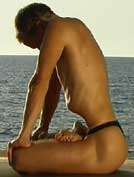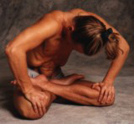The bandhas
The bandhas are the muscular response of the human body to active verticality. A response that if applied also in other situations releases the spine, supports respiration and stabilises and integrates all the joints of the body. Their fundamental function is to protect against gravity. This they do to protect the spine when we lengthen it by producing muscular activity in the pelvis, legs and feet. Their deliberate activition in the chest and arms also releases and protects the spine. When yoga postures are based on this organic process they becomes simple, effortless and powerful.
There are five bandhas that become three that become one in the integration that yoga is: jalandhara bandha, uddiyana bandha, mulabandha, hastbandha and padabandha. Jalandhara bandha is in the throat, Mulabandha in the pelvic bowl, Uddiyanabandha in the thorax: together they create Merubandha. When conmbined with Hastabandha in the arms and hands, and Padabandha in the feet and legs they create Sarvangabandha.
Mulabandha is a sustained activation of the accessory muscles of exhalation, in the lower abdomen between the groins. They lift the pelvic floor, causing a passive contraction of all of its muscles, but especially the centre. The muscles of the pelvic floor themselves must remain passive. The anus tightening will stimulate the sympathetic nervous system, hardening muscles, tightening sphincters, increasing heart rate and intercranial pressure, exciting respiration and externalising awareness. It results naturally andx structurall from lifitng the ribcage with integrity away from the pelvis.
Uddiyanabandha is a sustained activation of the accessory muscles of inhalation. These muscles are in the deep back and around the ribs, back, sides and front. They lift the whole ribcage while rotating the ribs, causing an expansion of the thoracic cavity within that lift. The lungs naturally enlarge into this expansion. These muscles can be activated independent from inhalation and then they lift the ribacge free from any thrusting of the breastbobne or ribs.
Jalandharabandha is a natural activation of muscles in the throat resulting from deep uddiyana bandha. It need not be addressed separately. To do so almost inevtably creates subtle tension in the throat, face, lungs and brain.
Hastabandha is broadening the finger bases while spirallically lentheining the arms: this require that the momentum of the top and bottom arm be opposed to each other. This opens and stabilises the shoulder joints while opening the thoracic cavity.
Padabandha is broadening and lengthening the feet in two directions so that a double spiral extend up the legs and stablises the opening of the pelvic joints. This stablises and releases the spine.
The bandhas are at the heart of structural and functional integrity. They create and express organised freedom and stability in every joint of the body. At the same time they have deep and nourishing physiological, neurological, energetic and spiritual impacts. All of which are based on recovering the dynamics of structural integrity. At their deepest heart is the clear and unequivocal realisation that everything is absolutely perfect (divine) just the way it is.
The bandhas are neither obscure nor mysterious. They are simply specific sets of judicious muscular contraction that organise and integrate the body parts into their inherent integrity and reveal the deeper untites within.


